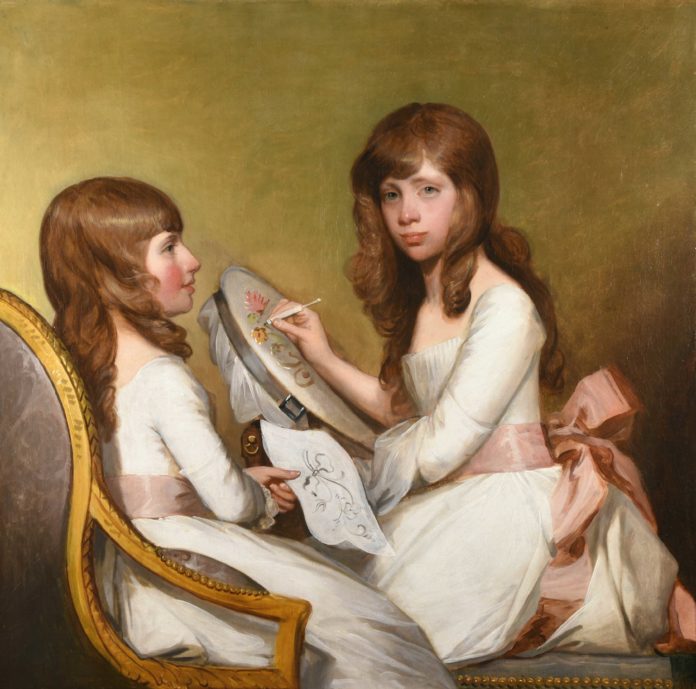Reynolda House Museum of American Art in North Carolina has acquired Gilbert Stuart’s double portrait “Anna Dorothea Foster and Charlotte Anna Dick” (1790–1791).
More from the museum:
Reynolda was generously given the work by Charlotte Metz Hanes, wife of the late R. Philip Hanes (Feb. 25, 1926 – Jan. 16, 2011), who said she is committed to supporting the arts in Winston-Salem and to continuing her husband’s legacy.
“Anna Dorothea Foster and Charlotte Anna Dick” was the first painting acquired by the industrialist and arts leader Phil Hanes. Charlotte Hanes explains her decision to donate the masterwork: “Phil was so committed to Winston-Salem’s legacy of the arts, and painting was such an early love for him, I just knew that the first work that he bought belonged in Winston-Salem. Other museums were interested in the painting, and it was shown at the Metropolitan Museum of Art and the National Gallery. But I thought it should remain in his beloved ‘city of the arts.’”
Barbara Babcock Millhouse, the Museum’s founding director and the visionary behind its art collection, said of the gift, “I never imagined that Reynolda House would ever have the opportunity to acquire another painting by Gilbert Stuart, since paintings of this quality are so rarely available today. I was delighted to learn that Charlotte Hanes had a keen interest in donating this work of art to Reynolda. We were honored to accept the gift, and I consider it a fitting way to honor Phil Hanes and his love of American art.”
The painting was executed in Dublin, where Stuart lived from 1787 until 1793. His time in Dublin was preceded by 12 years in London, where he studied the works of Reynolds, Romney, and Gainsborough and assisted Benjamin West with his artistic commissions. Stuart’s painting improved immeasurably during this time, developing a sophistication that was not present in his early works executed in America. He painted true likenesses, but also managed to create elegant and artful pictures that appealed greatly to his sitters. Stuart went on to paint for prominent political figures and social elites, including George Washington, and is known as the leading portrait artist of the Federalist period in American art history.
“Anna Dorothea Foster and Charlotte Anna Dick” has been featured previously in exhibitions at the Metropolitan Museum of Art, the National Gallery of Art, the Art Institute of Chicago, the Los Angeles County Museum of Art, and the Yale University Art Gallery.
About the painting
“Anna Dorothea Foster and Charlotte Anna Dick” shows Anna Dorothea Foster, the daughter of former Speaker of the House John Foster, on the right, and her cousin Charlotte Anna Dick on the left. It is known from a receipt that Foster commissioned portraits of himself and his family members. The girls had previously been identified, based on an inscription on the back of the work, as Miss Dick and Miss Foster, but art historian Carrie Rebora Barratt reattributed their identities to Miss Foster and Miss Dick based on several pieces of evidence, including the receipt and other portraits of the girls.
The portrait shows the girls dressed in similar ivory dresses with pink sashes. They bear a strong resemblance to each other, with long golden brown hair arranged in ringlets, blue eyes, and pink cheeks. Anna, on the right, holds a needlework frame called a tambour and a hook for pulling colored thread through the silk in the frame. As she was approaching her debut to society and marriageable age, this activity identifies her as a refined and accomplished young woman. Her cousin Charlotte holds a paper with the pattern for the embroidery. One can see the ease with which Stuart handles the paint, his surer figural modeling, an innovative approach to composition, and a delicate touch with color that confirms that the artist had certainly reached maturity in London.
Double portraits were unusual in Stuart’s work. In this portrait, he composed the figures successfully by slightly elevating Anna on the right and placing Charlotte in profile on the left. Reynolda’s Stuart portrait of Sally Foster Otis (1809) was intended to be a double portrait, as he originally included Sally’s son Alleyne. Ultimately, however, Stuart painted him out. Over the years, Alleyne’s face has emerged through the paint in a ghostly pentimento. A comparison of the portraits of Anna Dorothea Foster and Charlotte Anna Dick with the portrait of Sally Foster Otis in Reynolda’s collection will yield much rich material for discussion.
As of this publication, the museum is currently closed to the public due to growing health concerns. For more information, please visit the website of the Reynolda House Museum of American Art.
> Sign up to receive Fine Art Today, our free weekly e-newsletter
> And click here to subscribe to Fine Art Connoisseur magazine, so you never miss an issue








